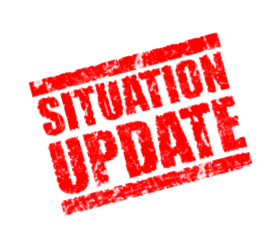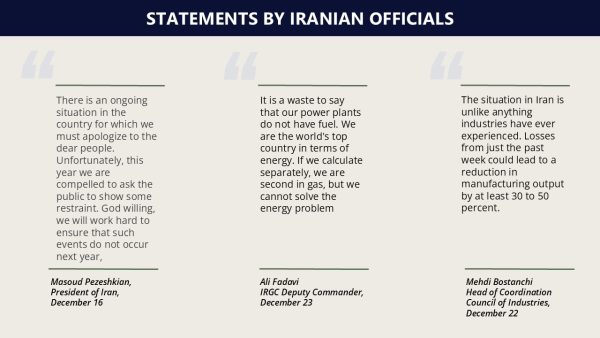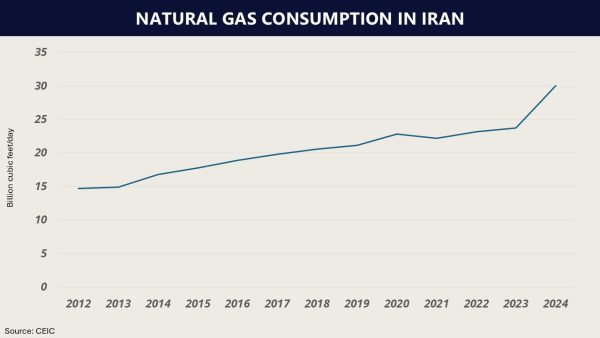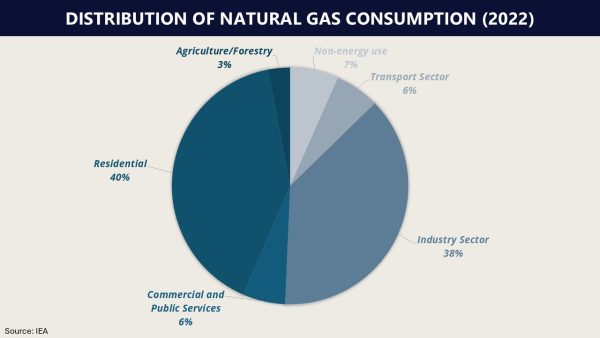03
Jan 2025
13:41 UTC
Iran SITUATION UPDATE: Energy crisis, currency depreciation to increase anti-government sentiment; unlikely to affect domestic stability at current juncture
Executive Summary:
- In recent weeks, several protests have erupted across Iran in response to frequent power cuts.
- The sharp depreciation of the Iranian Rial and elevated rates of inflation which have severely undermined citizens’ purchasing power is also adding to public discontent.
- The government is expected to continue rationing electricity over the coming weeks which may prompt additional protests driven by socio-economic grievances including in Tehran.
- That said, the absence of a unified opposition and concerns of a heavy-handed government crackdown will likely prevent these protests from escalating into a coordinated nationwide movement at the current time.
- This will significantly diminish the immediate threat posed by such protests to domestic stability.
Current Situation:
- Iran has been experiencing power shortages since November 2024, due to a limited supply of gas for fuelling power plants. As a result, the authorities in November announced scheduled blackouts for several hours daily in multiple provinces including Tehran.
- In December 2024, the authorities implemented various measures to conserve electricity, including reducing working hours for public offices and transitioning educational institutions to online platforms.
- On December 12, President Masoud Pezeshkian called on citizens to lower heating temperatures in their homes by two degrees Celsius as part of the government’s efforts to manage the energy crisis effectively.
- Since December 12, several major Iranian cities, including Tehran, have experienced intermittent power outages, with reports indicating that outages in Tehran have lasted up to two hours daily.
- On December 16, multiple protests by residents were reported in various cities, including Tehran, Karaj, and Isfahan. Protesters also burnt tires along the Tehran-Saveh highway to express their frustration over the power outages, causing traffic disruptions.
- By December 20, 17 power plants had been fully shut down with the remaining plants operating at partial capacity.
- On December 22, protests were held across multiple Iranian cities, including Tehran, Ahvaz, Shush, Kermanshah, and Shiraz, led by retired personnel, municipal employees, and workers from the telecommunications and oil and gas sectors denouncing deteriorating economic conditions, delayed salary payments, inadequate pensions, and rising inflation.
- On December 29-30, shopkeepers and business owners in Tehran’s Grand Bazaar reportedly staged a strike and protest, criticizing the government’s handling of economic issues, including high inflation rates and the depreciation of the Iranian Rial (IRR). A similar strike was also organized in Mashhad’s Atlas market.
- A state-run media report on December 31 indicated that prolonged power outages are forcing many industrial facilities, including gas power plants, to shift to using mazut, a low-quality and highly polluting heavy oil.
- The state-owned Tavanir power company cautioned producers and business owners to prepare for potential power outages that may last for several days or even weeks according to reports from December 22.
Assessments & Forecast:
Factors contributing to ongoing energy crisis:
- Iran’s natural gas consumption has risen sharply over the last decade, reaching a record 30.3 billion cubic feet (bcf) per day on December 19, 2024, compared to 16.77 bcf per day in 2014. This sharp increase has been driven by growing domestic demand, urbanization, and subsidized gas prices which have also resulted in the smuggling of Iranian gas to other countries. The expansion of energy-intensive industries, particularly petrochemicals and electricity generation, has further increased consumption, alongside government initiatives to transition from oil to gas and extend pipeline access to rural areas. Seasonal spikes, especially during the winter months, and inefficiencies in energy infrastructure that lead to wastage have also contributed to this trend.
- Thus, despite holding the world’s second-largest natural gas reserves, Iran has faced persistent gas shortages, especially during peak demand periods. In 2023, reports revealed a daily gas deficit of about 250 million cubic meters, which increased to 350 million cubic meters per day in 2024. This has also been exacerbated by international sanctions on Iran which have stifled foreign investment and limited access to advanced technology. Furthermore, the alleged sabotage of two major gas pipelines by Israel in February 2024 reportedly disrupted supply across several provinces, with the government yet to reportedly repair the damage.
Domestic impact of energy crisis:
- By the end of December 2024, nearly 17 power plants had reportedly shut down due to insufficient gas supplies resulting in the closure of 50 percent of Iran’s industrial parks. Compounded by recurring electricity shortages, these energy deficits have the potential to cost the Iranian economy five to eight billion USD annually. This underscores the extent of the adverse impact such shortages can have on the Iranian economy which is already weakened by international sanctions.
- Exacerbating the impact of the electricity crisis is the sharp decline of the Iranian rial (IRR), which fell to 801,000 IRR to the USD in late December, down from 584,000 IRR per USD in July. With inflation rates hovering around 32 percent year-on-year in December 2024, citizens have seen their purchasing power significantly diminish leading to discontent. In this context, the labor strike on December 29 in Tehran reflects growing frustrations among shopkeepers, traders, and business owners, driven by soaring inflation, rising raw material costs, and the domestic energy crisis which has reduced the number of hours commercial establishments can remain open thus lowering profits. Some protesters also chanted slogans against Supreme Leader Ayatollah Ali Khamenei indicating the prevailing belief that the nation’s leadership is mismanaging the economy.
- FORECAST: This frustration may fuel broader anti-establishment sentiments, potentially leading to more protests challenging the government’s handling of the economy and political leadership. It may also increase public discontent with Pezeshkian’s inability to deliver meaningful change. However, these protests are unlikely to directly challenge domestic stability at this point due to the absence of a unified opposition movement and fears that the government may respond with a heavy-handed crackdown, as seen in 2022. Nonetheless, small anti-government protests denouncing a host of socio-economic issues are expected to recur across Iran, including in Tehran, in the coming days.
Possible government response:
- In response to severe gas shortages, the Iranian government is likely to maintain rationing and scheduled outages to prioritize critical sectors such as hospitals and essential services. It may also consider further gas price hikes, in addition to the increases that came into effect from October 2024, to curb overconsumption. The restructuring of fuel subsidies based on certain conditions was also supported by President Masoud Pezeshkian who has criticized Iran’s low fuel prices in the past. However, the government is likely to remain wary of such a measure given the possibility of it triggering protests as was seen by the widespread nature of the 2019 anti-government protests which were prompted by a fuel price increase. Therefore, a significant hike in prices is less likely to materialize at the current time.
- Another possibility is a potential reduction by the Iranian government of gas exports to Iraq and Turkey in order to preserve supplies. Reports from December 2024 indicate that Iran has suspended exports to Iraq due to shortages. However, Iran is unlikely to reduce gas exports to Turkey, which have reportedly increased by 41 percent year-on-year in October 2024, due to the vital revenues this sale generates for the Iranian government.
- In the longer term, to mitigate the effects of an energy crisis, Iran may attempt to either increase gas imports or its electricity supply. Such attempts may take the form of deals signed earlier in 2024 including one in July with Russia’s Gazprom for the supply of 300 million cubic meters of gas daily, and a November gas-for-electricity exchange agreement with Armenia. That said, given that Iran has been sanctioned by Western countries, its ability to find foreign partners willing to enter into such agreements is relatively curtailed.
- Thus, for these reasons, the issue of electricity and gas shortages in Iran is likely to persist in the medium term. Tehran’s ability to sustainably resolve these shortages, as well as socio-economic issues such as elevated levels of inflation, depends to a large extent on its geopolitical situation which is currently precarious. For instance, there are growing concerns within Iran regarding the possibility of US President-elect Donald Trump reinstating a “maximum pressure” policy to curb Iran’s nuclear program. This would involve imposing further stringent economic sanctions targeting Iran’s oil and export revenues. This, combined with currently heightened tensions with Israel will continue to exert significant pressure on Iran in the near term and may hinder prospects for investment in critical sectors. In the absence of substantial reforms in the energy sector and broader economic framework, economic discontent is unlikely to subside in the near future.
Recommendations:
For electricity shortages:
- Those operating or residing in Iran are advised to allot for disruptions to business continuity due to the extensive electricity cuts reported in multiple Iranian cities including Tehran.
- Take necessary precautions to secure business continuity in the event of power cuts or shortages. Measures should include confirming that business locations have working generators, sufficient access to fuel for longer periods, and access to a number of flashlights. Ensure that you have instructions to start the generators and solve potential problems.
- Ensure you have spare batteries for flashlights.
- Ensure you have fully charged electronic devices such as cellular phones, laptops, and tablet computers ahead of the planned power outage, and initiate energy-saving functions on these devices as needed. Consider purchasing solar charges for the business for multiple devices.
- Disconnect all surge-prone devices such as computers, televisions, and appliances to prevent potential damage, or consider installing power surge electric adaptors for all main sockets feeding multiple or sensitive devices.
- Expect disruptions and delays in key travel and commercial infrastructure including airports.
General
- Business travel to Tehran, Isfahan, and other major cities may continue at this time, while adhering to basic security precautions regarding civil unrest and adherence to cultural norms. Western nationals are advised to remain cognizant of prevailing negative sentiment toward the United States and other North American and Western European countries.
- We advise against all travel to outlying border areas with Pakistan, Turkmenistan, Iraq, Azerbaijan, and Armenia due to ongoing militant activity. For this reason, maintain heightened vigilance in West Azerbaijan province, Kordestan Province, Kermanshah Province, Ilam Province, Khuzestan Province, and Sistan-Baluchistan Province.
- Those traveling to Iran should anticipate prolonged questioning by customs officials. Refrain from traveling with sophisticated cameras or other features affiliated with journalists. Cooperate with all security officials and respond to questioning in a respectable and calm manner.
- Refrain from discussing the current political situation, Iran’s nuclear program, or tensions with the United States, Gulf countries, and Israel with local residents as a basic precaution. Be advised that authorities may monitor communications from hotels and other facilities frequented by foreigners, while internet access may be limited.
- In the event that embassy services are required, it is advised to check the operational status of pertinent embassies and consulates. Consular services for US citizens are provided through the auspices of the Swiss Embassy in Tehran.
COUNTRY RISK LEVEL
High
AFFECTED AREA
Nationwide; Iran
INCIDENT RISK LEVEL
Medium
STRENGTH OF SOURCE
Confirmed
Executive Summary:
- In recent weeks, several protests have erupted across Iran in response to frequent power cuts.
- The sharp depreciation of the Iranian Rial and elevated rates of inflation which have severely undermined citizens’ purchasing power is also adding to public discontent.
- The government is expected to continue rationing electricity over the coming weeks which may prompt additional protests driven by socio-economic grievances including in Tehran.
- That said, the absence of a unified opposition and concerns of a heavy-handed government crackdown will likely prevent these protests from escalating into a coordinated nationwide movement at the current time.
- This will significantly diminish the immediate threat posed by such protests to domestic stability.
Current Situation:
- Iran has been experiencing power shortages since November 2024, due to a limited supply of gas for fuelling power plants. As a result, the authorities in November announced scheduled blackouts for several hours daily in multiple provinces including Tehran.
- In December 2024, the authorities implemented various measures to conserve electricity, including reducing working hours for public offices and transitioning educational institutions to online platforms.
- On December 12, President Masoud Pezeshkian called on citizens to lower heating temperatures in their homes by two degrees Celsius as part of the government’s efforts to manage the energy crisis effectively.
- Since December 12, several major Iranian cities, including Tehran, have experienced intermittent power outages, with reports indicating that outages in Tehran have lasted up to two hours daily.
- On December 16, multiple protests by residents were reported in various cities, including Tehran, Karaj, and Isfahan. Protesters also burnt tires along the Tehran-Saveh highway to express their frustration over the power outages, causing traffic disruptions.
- By December 20, 17 power plants had been fully shut down with the remaining plants operating at partial capacity.
- On December 22, protests were held across multiple Iranian cities, including Tehran, Ahvaz, Shush, Kermanshah, and Shiraz, led by retired personnel, municipal employees, and workers from the telecommunications and oil and gas sectors denouncing deteriorating economic conditions, delayed salary payments, inadequate pensions, and rising inflation.
- On December 29-30, shopkeepers and business owners in Tehran’s Grand Bazaar reportedly staged a strike and protest, criticizing the government’s handling of economic issues, including high inflation rates and the depreciation of the Iranian Rial (IRR). A similar strike was also organized in Mashhad’s Atlas market.
- A state-run media report on December 31 indicated that prolonged power outages are forcing many industrial facilities, including gas power plants, to shift to using mazut, a low-quality and highly polluting heavy oil.
- The state-owned Tavanir power company cautioned producers and business owners to prepare for potential power outages that may last for several days or even weeks according to reports from December 22.
Assessments & Forecast:
Factors contributing to ongoing energy crisis:
- Iran’s natural gas consumption has risen sharply over the last decade, reaching a record 30.3 billion cubic feet (bcf) per day on December 19, 2024, compared to 16.77 bcf per day in 2014. This sharp increase has been driven by growing domestic demand, urbanization, and subsidized gas prices which have also resulted in the smuggling of Iranian gas to other countries. The expansion of energy-intensive industries, particularly petrochemicals and electricity generation, has further increased consumption, alongside government initiatives to transition from oil to gas and extend pipeline access to rural areas. Seasonal spikes, especially during the winter months, and inefficiencies in energy infrastructure that lead to wastage have also contributed to this trend.
- Thus, despite holding the world’s second-largest natural gas reserves, Iran has faced persistent gas shortages, especially during peak demand periods. In 2023, reports revealed a daily gas deficit of about 250 million cubic meters, which increased to 350 million cubic meters per day in 2024. This has also been exacerbated by international sanctions on Iran which have stifled foreign investment and limited access to advanced technology. Furthermore, the alleged sabotage of two major gas pipelines by Israel in February 2024 reportedly disrupted supply across several provinces, with the government yet to reportedly repair the damage.
Domestic impact of energy crisis:
- By the end of December 2024, nearly 17 power plants had reportedly shut down due to insufficient gas supplies resulting in the closure of 50 percent of Iran’s industrial parks. Compounded by recurring electricity shortages, these energy deficits have the potential to cost the Iranian economy five to eight billion USD annually. This underscores the extent of the adverse impact such shortages can have on the Iranian economy which is already weakened by international sanctions.
- Exacerbating the impact of the electricity crisis is the sharp decline of the Iranian rial (IRR), which fell to 801,000 IRR to the USD in late December, down from 584,000 IRR per USD in July. With inflation rates hovering around 32 percent year-on-year in December 2024, citizens have seen their purchasing power significantly diminish leading to discontent. In this context, the labor strike on December 29 in Tehran reflects growing frustrations among shopkeepers, traders, and business owners, driven by soaring inflation, rising raw material costs, and the domestic energy crisis which has reduced the number of hours commercial establishments can remain open thus lowering profits. Some protesters also chanted slogans against Supreme Leader Ayatollah Ali Khamenei indicating the prevailing belief that the nation’s leadership is mismanaging the economy.
- FORECAST: This frustration may fuel broader anti-establishment sentiments, potentially leading to more protests challenging the government’s handling of the economy and political leadership. It may also increase public discontent with Pezeshkian’s inability to deliver meaningful change. However, these protests are unlikely to directly challenge domestic stability at this point due to the absence of a unified opposition movement and fears that the government may respond with a heavy-handed crackdown, as seen in 2022. Nonetheless, small anti-government protests denouncing a host of socio-economic issues are expected to recur across Iran, including in Tehran, in the coming days.
Possible government response:
- In response to severe gas shortages, the Iranian government is likely to maintain rationing and scheduled outages to prioritize critical sectors such as hospitals and essential services. It may also consider further gas price hikes, in addition to the increases that came into effect from October 2024, to curb overconsumption. The restructuring of fuel subsidies based on certain conditions was also supported by President Masoud Pezeshkian who has criticized Iran’s low fuel prices in the past. However, the government is likely to remain wary of such a measure given the possibility of it triggering protests as was seen by the widespread nature of the 2019 anti-government protests which were prompted by a fuel price increase. Therefore, a significant hike in prices is less likely to materialize at the current time.
- Another possibility is a potential reduction by the Iranian government of gas exports to Iraq and Turkey in order to preserve supplies. Reports from December 2024 indicate that Iran has suspended exports to Iraq due to shortages. However, Iran is unlikely to reduce gas exports to Turkey, which have reportedly increased by 41 percent year-on-year in October 2024, due to the vital revenues this sale generates for the Iranian government.
- In the longer term, to mitigate the effects of an energy crisis, Iran may attempt to either increase gas imports or its electricity supply. Such attempts may take the form of deals signed earlier in 2024 including one in July with Russia’s Gazprom for the supply of 300 million cubic meters of gas daily, and a November gas-for-electricity exchange agreement with Armenia. That said, given that Iran has been sanctioned by Western countries, its ability to find foreign partners willing to enter into such agreements is relatively curtailed.
- Thus, for these reasons, the issue of electricity and gas shortages in Iran is likely to persist in the medium term. Tehran’s ability to sustainably resolve these shortages, as well as socio-economic issues such as elevated levels of inflation, depends to a large extent on its geopolitical situation which is currently precarious. For instance, there are growing concerns within Iran regarding the possibility of US President-elect Donald Trump reinstating a “maximum pressure” policy to curb Iran’s nuclear program. This would involve imposing further stringent economic sanctions targeting Iran’s oil and export revenues. This, combined with currently heightened tensions with Israel will continue to exert significant pressure on Iran in the near term and may hinder prospects for investment in critical sectors. In the absence of substantial reforms in the energy sector and broader economic framework, economic discontent is unlikely to subside in the near future.
Recommendations:
For electricity shortages:
- Those operating or residing in Iran are advised to allot for disruptions to business continuity due to the extensive electricity cuts reported in multiple Iranian cities including Tehran.
- Take necessary precautions to secure business continuity in the event of power cuts or shortages. Measures should include confirming that business locations have working generators, sufficient access to fuel for longer periods, and access to a number of flashlights. Ensure that you have instructions to start the generators and solve potential problems.
- Ensure you have spare batteries for flashlights.
- Ensure you have fully charged electronic devices such as cellular phones, laptops, and tablet computers ahead of the planned power outage, and initiate energy-saving functions on these devices as needed. Consider purchasing solar charges for the business for multiple devices.
- Disconnect all surge-prone devices such as computers, televisions, and appliances to prevent potential damage, or consider installing power surge electric adaptors for all main sockets feeding multiple or sensitive devices.
- Expect disruptions and delays in key travel and commercial infrastructure including airports.
General
- Business travel to Tehran, Isfahan, and other major cities may continue at this time, while adhering to basic security precautions regarding civil unrest and adherence to cultural norms. Western nationals are advised to remain cognizant of prevailing negative sentiment toward the United States and other North American and Western European countries.
- We advise against all travel to outlying border areas with Pakistan, Turkmenistan, Iraq, Azerbaijan, and Armenia due to ongoing militant activity. For this reason, maintain heightened vigilance in West Azerbaijan province, Kordestan Province, Kermanshah Province, Ilam Province, Khuzestan Province, and Sistan-Baluchistan Province.
- Those traveling to Iran should anticipate prolonged questioning by customs officials. Refrain from traveling with sophisticated cameras or other features affiliated with journalists. Cooperate with all security officials and respond to questioning in a respectable and calm manner.
- Refrain from discussing the current political situation, Iran’s nuclear program, or tensions with the United States, Gulf countries, and Israel with local residents as a basic precaution. Be advised that authorities may monitor communications from hotels and other facilities frequented by foreigners, while internet access may be limited.
- In the event that embassy services are required, it is advised to check the operational status of pertinent embassies and consulates. Consular services for US citizens are provided through the auspices of the Swiss Embassy in Tehran.




